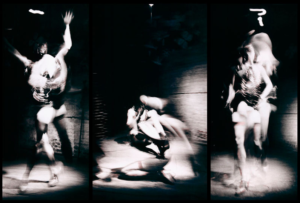The artist Torsten Warmuth lives in Berlin, but he has been making photographic forays into other metropolises such as New York, Paris, Buenos Aires or Cairo since the mid-nineties. Warmuth’s images seek to capture the fleeting qualities of life; they are energised by rippling mists, a deliberate lack of clarity that conceals the emotions and impetus behind entire societies. Generally, they show man’s disquiet in the big city. Yet as so often in the work of this artist, who was born in 1968, it is not a matter of conveying traceable places, but of gathering dreamily murmured scenarios. Beyond the concrete aspects – of fashions, accessories, poses – it seems that urban spaces are no more to him than playgrounds for eternally unchanging phenomena.
Like the great flaneur of the past century, he understands urban space as modernity’s extreme – as the place where customary patterns of order and perception dissipated long ago. In the constant flow and rhythm of permanent simultaneity, it is no longer possible to grasp any substantial reality. Recognition exists only as subjective contemplation, incessantly evading us and being restored.

In this respect, Warmuth’s images recall Siegfried Kracauer’s maxim from the year 1929: “Spatial images are the dreams of society”. Long ago, perception of our big cities ceased to be a matter of grasping the factual using optical means and became a revisualisation of the fleetingly fragile.
Using extended exposure times, Warmuth creates a lack of clarity, softening lines and producing blurs. In this way, dynamic foregrounds emerge from the fixed depths.
Warmuth’s 4×5 large format camera becomes a weapon against the passage of time. In the huge metropolises – in the midst of the traffic’s staccato, the chaos on the pavements and the ‘whispered glances’ of passers-by – he isolates fractions of a second. By means of montage and double exposures, he turns chronological sequences into rhythmic juxtaposition. The outcome is a strange spatial depth. What can be seen is the simultaneity of the non-simultaneous. A directly poetic magic. Time turns into space and space turns into time.
Photography is the ‘medium of melancholy’. It has always enjoyed a peculiar correlation to history and the moment. It concentrates whatever has been and reveals things that may be some day. ‘Time’, to quote the philosopher Roland Barthes, is crushed into small pieces by photography. Warmuth’s images slip irrevocably into trance and dreaming.
Clarity is blurred against their nocturnal backdrops and identities slip past in nightly intoxication.
And so a different image lies in wait behind every image in Warmuth’s work, and an earlier time lingers behind every time. In the end, when every gaze has long since drifted, exhausted, into the unknown, all that remains of this night is an abstract intoxication – depicted so impressively in the large triptych In the Arena. We see a dancing creature, but we are no longer able to say whether it is man or woman; a human being or an animal. The French poet Charles Baudelaire once wrote a magnificent poem about just such a night and such a confusing charade. The poem is entitled Le Crépuscule du soir, and in it we read: “Heaven, like a garret, closes to the day / And Man, impatient, turns a beast of prey.” No more suitable phrases could be set as a caption alongside Warmuth’s pictures.
Warmuth’s work will convert anyone who believes that good photographic art from Germany can only be straight-lined and sober: Its beauty appears at the place where everything slips away.














